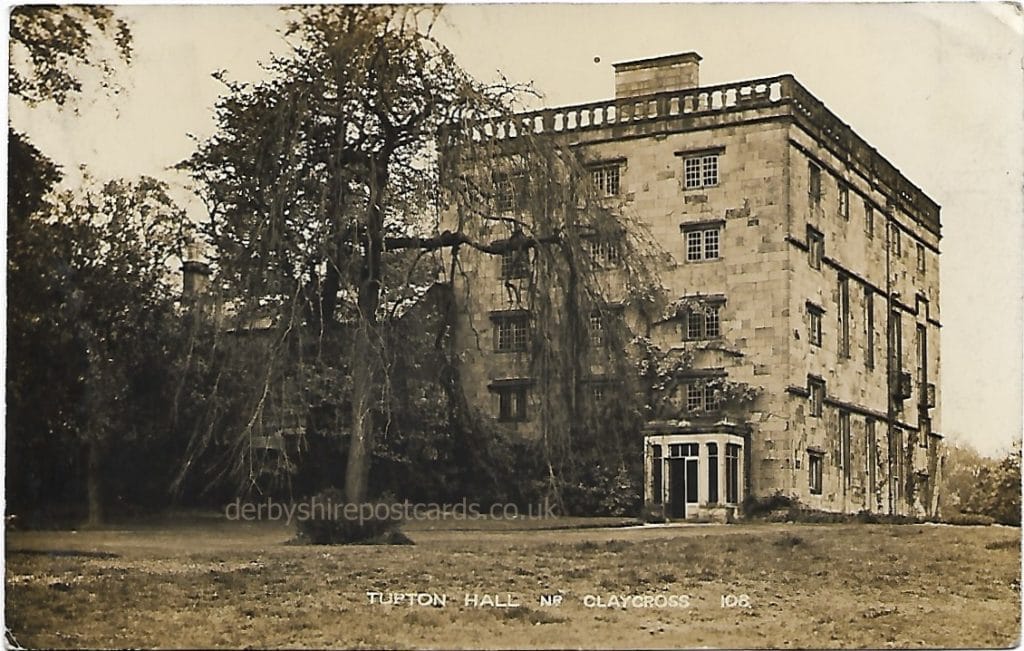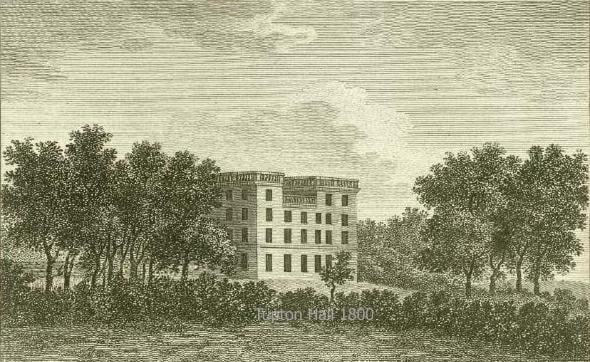Tupton Hall, origin of the estate is obscure and it emerges only in the thirteenth century, being held under the manor of North Wingfield by the family of Tupton. By 1293 it had come to Robert, third son of Richard de Riboeuf of Etwall and Stretton in Shirland.
Robert married Juliana, widow of John de Hollins, who may have been the Tupton heiress. On the death of his great grandson, Robert, the estate seems to have passed to Ralph Hunt of Treeton, Nottinghamshire, a son of Richard, of Ashover. In view of the fact that Robert, uncle of Robert Riboeuf of Tupton, was of Ashover, it may be that the former left an heiress married to Ralph Hunt and that she was next heir of Robert Riboeuf of Tupton. The Hunts held the estate into the sixteenth century when it was purchased by the Gladwins at the beginning of the seventeenth; they were connected to the Cavendish family, which adds to the likelihood that John and Robert Smythsons had a hand in the design of the house they built.
Tupton Hall was acquired by Thomas Gladwin (1630-97) who was Sheriff of Derbyshire in 1667/8 and son of wealthy lead merchant Thomas Gladwin (1593-c 1671) of Boythorpe who had earlier acquired, amongst other property, Eddlestow Hall, the manor of Coal Aston and two-thirds of the lead-producing manor of Monyash. He was himself one of the foremost lead merchants in the county and ostentatiously placed his and his wife Helen’s names in large letters on the roof balustrade.
In 1721, Thomas Gladwin left it to his youngest brother, Lemuel, who began to mine coal extensively. His son’s heiress brought it, before 1747, to her husband, William Allwood of Wickersley (Yorks.) – under whom the house was tenanted by Samuel Tateham and whose heiress married into the Lord family.
Thomas’s eldest son and heir was Lemuel Gladwin, whose eventual heiress in the female line married a Mr Lord, whose descendants inherited the estate and made it their residence. His grandson was William Allwood Lord, Esq., who in 1817 was seated at Tupton Hall.
One of the Lord family owners, a wealthy Chesterfield miller (after which family Lordsmill Street, Chesterfield was named) was robbed by a masked highwayman. He suspected his own coachman of having been the robber, but his other staff supported his alibi that he had been in the house at the time of the crime. Nevertheless, Lord had him tried, convicted and hanged. Before his execution the coachman laid a curse on the family and predicted “disaster upon disaster would follow”.
Shortly before 1893 the family sold the estate and at that time a distant cousin Rev. Henry Gladwin Jebb, descended in the female line from Major-General Henry Gladwin (d.1791), purchased ten Gladwin family portraits formerly hanging in Tupton Hall, including one of Thomas Gladwin dated 1672, and some family silver-plate also dated 1672.
William Allwood Lord probably did the rebuilding of the house, and his like-named son sold to Dr Frederick Packman, who later let the house to Joseph Cokayne, a timber merchant who had grown rich by supplying his landlord with pit-props.
Right at the end of the century, F.W.V.Packman let it to Arthur Gorell Barnes of Ashgate who was followed by a Mrs. Cogan. Packman’s widow moved back before 1914, but after the war Tupton was the home of W.H. Allibon, then the county surveyor, followed by Maj. H. H. Jackson of the Clay Cross family.
It was sold to the Derbyshire County Council in 1929 (whose architects department, mercifully, drew it in detail), and it was adapted as part of Clay Cross County Secondary School, the foundation stone for some extensions being laid 3rd April, 1935, and it opened in September 1936. This ultimately proved its undoing, as it was damaged by fire early in July, 1938 and the forlorn shell was cleared away the following year as unsafe. In due course a new school arose on the site.
In 1929 Derbyshire Education Committee purchased Tupton Hall and its 52-acre park. In 1938 the house was destroyed in a fire, soon after an ornamental plaster ceiling by Robert Adam was refurbished, and the remains were demolished soon after.
This early seventeenth century tower house miraculously survived into the mid twentieth century. It was built of ashlar, probably Millstone grit sandstone from the Alton-Ashover area, the style points to it being attributable to John or Robert Smythson who some connect with Wingerworth Hall. Smythson also designed nearby Hardwick Hall and Barlborough Hall.
Originally the house was of three and five stories with its main front facing South. Three stories formed the middle of the house whilst the West and East ends were effectively towers of five stories. It would appear that the original centre of the house was lower and built up to match later in the eighteenth century. Many other alterations were made over time.
This famous engraving of Tupton Hall is something of a mystery as it shows a six bay, three storey tower house of the right approximate date, with two four storey towers at each end. However Tupton Hall was five by three bays of five storeys at the ends and three string courses not one (see postcard above). Either it was drawn from memory or is another house altogether which is probably the case.
ref 1,2,3
In 1929 Derbyshire Education Committee purchased Tupton Hall and its 52-acre park. In 1938 the house was destroyed in a fire, soon after an ornamental plaster ceiling by Robert Adam was refurbished, and the remains were demolished. Tupton Hall School buildings were then built on the site nothing to be seen of the old Tupton Hall when I attended Tupton Hall Grammar School.



